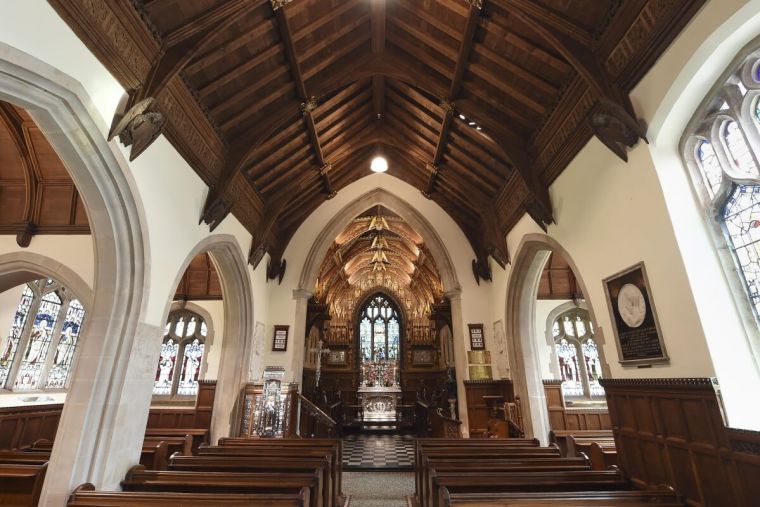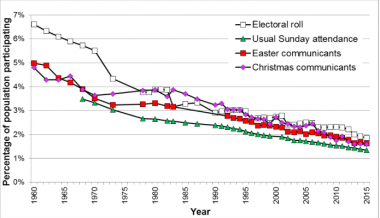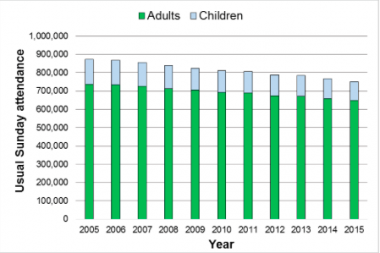Why Do People Stop Going To Church? Church of England Fails To Halt Decline

Sunday churchgoing has plummeted to an unprececedented new low, according latest figures from the Church of England.
Sunday attendance slumped from 875,000 in 2005 to just 752,460 last year, a fall of 14 per cent in a decade. according to the statistics published today.
Even when weekday attendance is taken into account, fewer than one million people now go to services of the established Church.
The Church, which has published attendance figures since 1960, has put in place a new programme of "reform and renewal" to confront the crisis where membership, measured by names on the Church's own electoral roll, has fallen from just under seven per cent of the population in 1969 to just under two per cent last year.
Sunday attendance is at a record low at just over one per cent of the population.


In its report, the Church says that reasons for joining or leaving a worshipping community "are not necessarily known".
By far the biggest reason given was death or illness, cited by clergy in 44 per cent of cases where they lost a worshipper.
Nearly a third of people left a church when they moved away.
More than one in ten moved to another church, and a similar number left the church altogether.
The reason for this was not given.
The Church report admits: "Over recent decades, attendance at Church of England church services has gradually fallen.
"These trends continued in 2015. Most key measures of attendance have fallen by between 10 per cent and 15 per cent over the past 10 years."
However, there has been a big difference between individual parishes. In more than half of parishes there was no change in attendance over the decade, while in one in ten, attendance actually increased. Nearly four in ten showed a decrease.
The total worshipping community of churches across the Church of England in 2015 was 1,142,000 people, of which one in five was aged under 18, half were aged 18-69 and three in ten were over 70.
Hereford and Gloucester dioceses had highest levels of participation as a percentage of the population, with Birmingham and Chelmsford the lowest.
One in ten births in Engand led to a Church of England baptism. Three in ten deaths led to a Church of England funeral.
William Nye, secretary general of the Archbishops' Council, said: "The Church of England is setting out on a journey of renewal and reform, aiming to reverse our numerical decline in attendance so that we become a growing church in every region and for every generation.
"The Church of England is open to and for everyone in England, building up the body of Christ and working for the common good. For some of those who support our work, weekly attendance at services is part of their discipleship. There will be many others, as we know from the Census, who identify with us but who worship on a less regular basis.
"These figures represent a realistic assessment of where we start from in terms of weekly attendance. We are confident in a hopeful future where our love of God and service of neighbour will form the basis for future growth.
"Statistics for Mission provides an invaluable foundation for this and demonstrates that the Church, fully aware of where we are yet confident of the future, still has a strong base to work from."
General Synod member Jayne Ozanne told Christian Today: "The Church of England needs to have the courage to look decline directly in the face and have the humility to ask 'Why?'.
"As my recent YouGov poll clearly shows many - even within the Church - do not believe it is there for everyone, as the Secretary General so confidently asserts. Indeed the young and those of 'no religion" - who we need to reach most - have the most negative perception of the Church. Growth will only come through a honest assessment of the mistakes we have made and a humble admission of the pain we have caused to so many."
Rev Peter Ould, a banking analytics consultant and a Church of England priest based in Canterbury, said: "The latest statistics for mission indicate a continuing fall in church attendance. In among the aggregated decline is evidence that a few dioceses are beginning to see stable figures.
"These are encouraging signs, but we need to be able to ask open and honest practical and spiritual questions about why some dioceses are bucking the trend and others are seeing accelerated decline."











